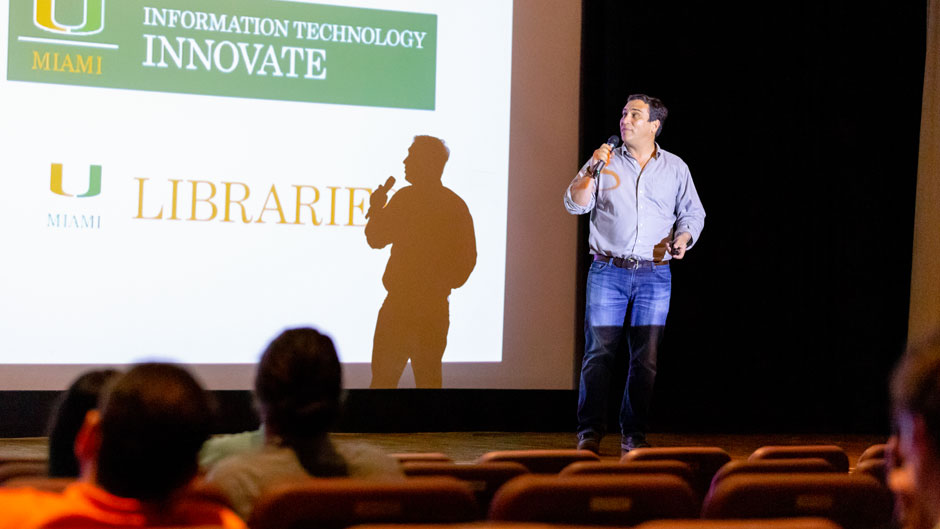A clothing line created specifically for avatars. Flight training simulators that rival a real-life experience in the air. And a digital replica of a city to attract new businesses, with the ability for visitors to walk the landscape, see the infrastructure, and observe properties available—all in virtual reality.
These projects already exist using immersive technology.
Industry leaders from the virtual, mixed, and augmented reality fields challenged students to think about what else is possible in the metaverse Thursday night during a launch of the VR/AR Association’s Miami chapter hosted on the Coral Gables Campus at the Bill Cosford Cinema.
“How will these technologies change the way we play, learn, and work?” asked John Cunningham, president of the central Florida VR/AR Association, who works as head of government and aerospace for Unity, a software tool used to build virtual and augmented reality experiences.
The University of Miami recently became a member of the VR/AR Association (VRARA), allowing all faculty members and students to take advantage of the professional organization’s stockpile of resources available to help create applications in virtual, mixed, and augmented reality. Kim Grinfeder, associate professor and chair of the Department of Interactive Media and director of the XR Initiative, joined the organization a few years ago and found it very useful, so he worked to get the entire University involved.
“Faculty and students will now have access to their educational materials, job search platforms, online training classes, research, and a network of companies and industry professionals working in the immersive space,” said Grinfeder, who shared student and faculty XR projects during the event, including a class he is co-teaching where both students and professors attend in virtual reality.
The international VRARA, which has chapters in 50 countries, had just one chapter in central Florida, started four years ago. With the launch of its Miami chapter, led by Tarja Stevens, chief executive of Metaverse Inclusive, the organization will tap into a growing South Florida tech industry, and VRARA founder and president Nathan Pettyjohn was excited about the new addition.
“We started this because we knew that we needed to build a community of people that could help each other grow their business, help them connect, and help them learn,” said Pettyjohn, who also works full time at Lenovo as its Commercial AR/VR lead. “Today, we have a little over 700 organizations that are paying members around the world, which equates to thousands of community members. So, there’s this awesome group of people striving to do more in this industry, and we are trying to help all of them achieve greatness,” he added.
During the launch, titled “The Intersection of AI and the Metaverse,” Cunningham and keynote speaker Amy Peck, the CEO of Endeavor XR, tried to debunk the notion that the metaverse is a new concept. First coined in Neal Stephenson’s 1992 novel “Snow Crash,” the term was popularized by Facebook’s new rebrand as Meta, although Peck said it is often misunderstood. One simple way of understanding the metaverse is “It’s the internet in 3D,” she said.
Peck encouraged the audience to think about how they can shape the metaverse, as it evolves and becomes more commonplace. The CEO said that she imagines a time soon when people will simply put on their glasses while they are walking down the street, and if they wonder what a building looked like in the 1800s, an image will appear on the lens. Or, if they are curious about someone’s profession, the glasses could pull up a LinkedIn profile.
Cunningham explained how virtual reality has quickly expanded from a tool to enhance video games to one that will soon impact every facet of our economy.
“A 3D model is pretty, but when you add data to it, that becomes a digital twin,” he said.
Cunningham added that a growing number of companies are using digital twins as a test bed for ideas they may later implement in the physical world. For example, Hyundai is building a digital twin of its innovation center and factory in Singapore. Meanwhile, Samsung is building a digital twin of its storefronts, so shoppers can buy things in the metaverse, which will later be sent to them in the mail.
The University’s Institute for Data Science and Computing launched its Digital Twins Lab this semester, a space that will allow students to work on these types of projects, merging immersive experiences with real-world data.
While the immersive tech industry continues to grow, Peck urged audience members to get involved in helping to ensure privacy and transparency will be a part of the metaverse. She said it needs to be accessible, created with diverse minds, and socially responsible.
“The metaverse is not just technology, it’s a story of humanity because it’s here to augment the human experience,” she said. “My challenge to you is to paint a perfect picture of that future—if you have a fantasy, it doesn’t have to be based in reality. The possibilities are infinite.”
Learn more about VRARA. Members say one of the best ways to get involved is to join a vertical/committee, and Grinfeder urged those interested to join the VRARA slack channel.

